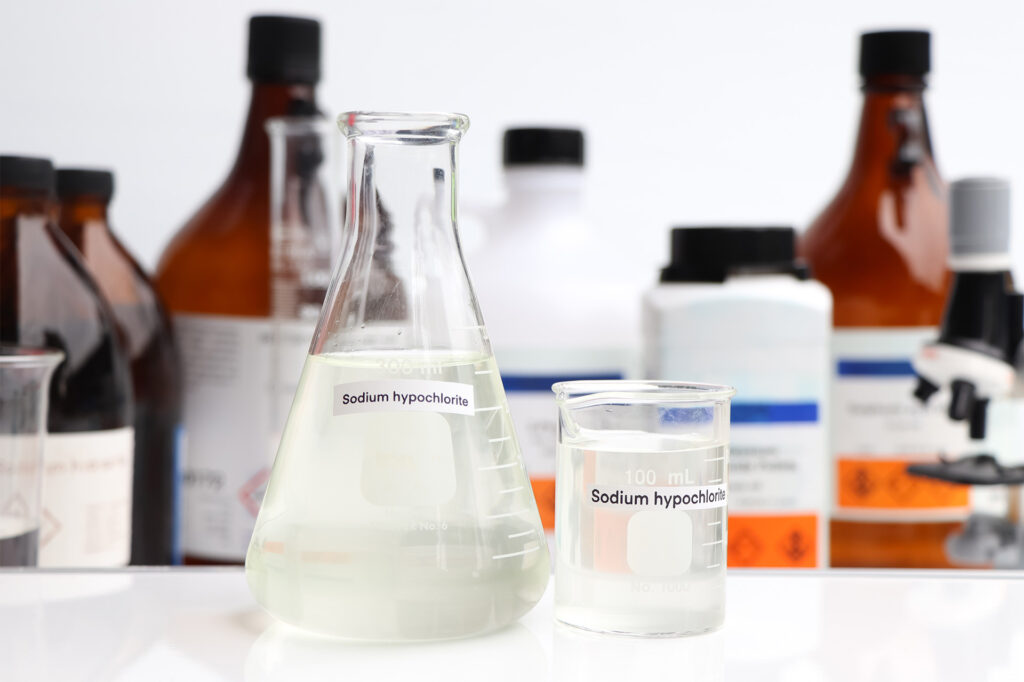When compared to other disinfectants commonly used in healthcare settings, HOCl offers several advantages.
First, and most importantly, it has the perfect balance between safety and efficacy. Many other solutions are either safe but not very effective, or unsafe, but extremely effective.
Second, HOCl, is non-toxic, non-irritating, and often achieves the lowest level (Category IV) on the EPA’s acute toxicity scale. Unlike many chemical disinfectants that may cause harm or damage to equipment or materials, HOCl is generally compatible with a variety of surfaces, including many metals, plastics, and fabrics.
Third, most other disinfectants do not carry a neutral charge like HOCl, which makes it harder for them to attract negatively charged bacteria and penetrate and disrupt cell walls.
Fourth, HOCl leaves little to no residue on hard surfaces. Residues increase the opportunity for microbes to proliferate. Due to this, and its 100% biodegradability factor, HOCl is used in organic food production facilities.
The primary disinfectants that compete with HOCl are included in the chart. None of these alternatives comprise both efficacy and non-toxicity as well and as comprehensively as HOCl. In addition, none of them are an endogenous substance in all mammals, as is HOCl, which naturally fight infection.
| Property | Hypochlorous Acid | Alcohol | Bleach | Peroxide | Quaternary Ammonium | Peracetic Acid + H2O2 | Phenolics |
| Disinfection | √ | √ | √ | √ | √ | √ | √ |
| Virucidal | √ | √ | √ | √ | √ | √ | √ |
| Fungicidal | √ | X | √ | √ | √ | √ | √ |
| Sporicidal (C-diff) | X | X | √ | X | X | √ | X |
| Sanitizer | √ | √ | √ | √ | √ | √ | √ |
| Shelf life, years* | X | √ | √ | √ | √ | X | √ |
| Non-toxic | √ | X | X | X | X | X | X |
| Rinse-free/Residue | √ | √ | X | √ | X | √ | X |
| Surface/Material compatible | √ | √ | X | √ | X | X | √ |
| Environmentally friendly | √ | X | X | √ | X | X | X |
| Biodegradeable | √ | X | √ | √ | X | √ | X |
| Low Odor/Fume | √ | X | X | √ | √ | X | √ |
| Non-flammable | √ | X | √ | √ | √ | √ | √ |
| No added dyes and fragrances | √ | √ | √ | √ | √ | √ | X |
| No Volatile Organic Compounds (VOC) | √ | X | X | X | √ | X | X |
Alcohol
The FDA has not cleared any liquid chemical sterilant or high-level disinfectant with alcohol as the main active ingredient. Alcohol is highly flammable, can damage plastic materials, can cause skin irritation and its efficacy is limited if organic matter is present.
Bleach
Bleach can be highly corrosive and toxic, causing irritation to skin, eyes and respiratory systems. According to the CDC, bleach can produce ocular irritation or oropharyngeal, esophageal, and gastric burns. It requires careful handling and proper ventilation due to its potential to release harmful fumes.
Hydrogen Peroxide
HOCl is considered more effective for wound care than hydrogen peroxide because it effectively kills bacteria while being significantly less damaging to healthy tissue, meaning it is less likely to impede the wound healing process.
It is less cytotoxic, has anti-biofilm activity, and promotes healing with minimal irritation. In comparison, hydrogen peroxide can harm healthy cells around the wound site and potentially delay healing.
Quaternary Ammonium
Studies show Quats to be low level disinfectants. More importantly, the primary chemicals in Quats have shown to be lung irritants and can contribute to asthma and other breathing problems. They irritate skin and can lead to rashes.
Peracetic Acid + Hydrogen Peroxide
The main problems with using a mixture of peracetic acid and hydrogen peroxide as a disinfectant are its high corrosiveness, potential for severe skin and eye irritation, respiratory irritation from vapors, and the need for careful handling due to its strong oxidizing properties; even at diluted concentrations, exposure can be harmful if proper safety measures aren’t taken.
Phenolics
The primary problem with phenolics as a disinfectant is their high toxicity, which can cause skin irritation, burns, eye irritation, and even systemic poisoning if inhaled or absorbed through the skin, even at relatively low concentrations; this makes them a significant health concern, especially with prolonged exposure or improper handling.







